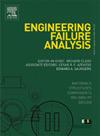Failure analysis of mantle/head liner of a cone crusher at a diamond mine in botswana
IF 5.7
2区 工程技术
Q1 ENGINEERING, MECHANICAL
引用次数: 0
Abstract
Cone crusher basic operation entails the application of compressive force between a gyrating mantle and a stationary bowl. The mantle and bowl are shielded with manganese steel liners, which wear away during operation and are the most replaced components. The mantle liner (ML) of a diamond mine in Botswana requires replacement at an average of 3600 h of operations, 720 h short of the manufacturer’s 4320 h expectancy. This study analyses ML failure modes and mechanisms while suggesting measures to mitigate this recurring mining operational challenge. This study used a combination of visual inspections, metallurgical investigation, and microstructural studies to provide insight into the failure. The results established abrasive wear, plastic deformation, subsurface cracking, tribocorrosion-induced cracking (TIC), and surface fracture as the ML failure modes. Abrasive wear initiates ML degradation through microcutting, ploughing, microcracking, pitting, and spalling. Impact forces during crushing of kimberlite ore containing hard minerals such as diamond and quartz induces plastic deformation, leading to twinning-induced plasticity (TWIP) and strain accumulation, which promotes the initiation of subsurface cracks along weakened grain boundaries. Cyclic loading promotes the propagation of existing intergranular cracks, which eventually forms surface fracture. Furthermore, corrosion products on the liner’s inner section (Al2O3, MgO, and CaO) contributed to TIC. This can further interact with subsurface cracks, accelerating failure. The root cause of the ML failure was identified as grain boundary weakening. Measures to mitigate the failure modes include optimisation of the feed distribution system, using corrosion inhibitors during storage, grain boundary-strengthening alloys incorporation, and advanced remanufacturing.
博茨瓦纳某钻石矿圆锥破碎机套头衬板失效分析
圆锥破碎机的基本操作需要在旋转的地幔和静止的碗之间施加压缩力。罩和碗用锰钢衬垫屏蔽,在操作过程中磨损,是更换最多的部件。博茨瓦纳钻石矿的地幔衬管(ML)需要在平均3600小时的作业时间内更换,比制造商4320小时的预期时间短720小时。本研究分析了机器学习的故障模式和机制,同时提出了缓解这种反复出现的采矿作业挑战的措施。这项研究结合了目视检查、冶金研究和显微组织研究来深入了解故障。结果表明,磨粒磨损、塑性变形、亚表面裂纹、摩擦腐蚀诱发裂纹(TIC)和表面断裂是ML失效模式。磨料磨损通过微切削、犁耕、微裂、点蚀和剥落引发ML退化。含金刚石、石英等硬矿物的金伯利岩矿石破碎过程中的冲击力诱发塑性变形,导致孪晶诱发塑性(TWIP)和应变积累,促进沿弱晶界萌生地下裂纹。循环加载促进了原有晶间裂纹的扩展,最终形成表面断裂。此外,内层的腐蚀产物(Al2O3、MgO和CaO)对TIC也有贡献。这可能进一步与地下裂缝相互作用,加速破坏。ML失效的根本原因被确定为晶界弱化。缓解失效模式的措施包括优化进料分配系统,在储存期间使用缓蚀剂,加入晶界强化合金以及先进的再制造。
本文章由计算机程序翻译,如有差异,请以英文原文为准。
求助全文
约1分钟内获得全文
求助全文
来源期刊

Engineering Failure Analysis
工程技术-材料科学:表征与测试
CiteScore
7.70
自引率
20.00%
发文量
956
审稿时长
47 days
期刊介绍:
Engineering Failure Analysis publishes research papers describing the analysis of engineering failures and related studies.
Papers relating to the structure, properties and behaviour of engineering materials are encouraged, particularly those which also involve the detailed application of materials parameters to problems in engineering structures, components and design. In addition to the area of materials engineering, the interacting fields of mechanical, manufacturing, aeronautical, civil, chemical, corrosion and design engineering are considered relevant. Activity should be directed at analysing engineering failures and carrying out research to help reduce the incidences of failures and to extend the operating horizons of engineering materials.
Emphasis is placed on the mechanical properties of materials and their behaviour when influenced by structure, process and environment. Metallic, polymeric, ceramic and natural materials are all included and the application of these materials to real engineering situations should be emphasised. The use of a case-study based approach is also encouraged.
Engineering Failure Analysis provides essential reference material and critical feedback into the design process thereby contributing to the prevention of engineering failures in the future. All submissions will be subject to peer review from leading experts in the field.
 求助内容:
求助内容: 应助结果提醒方式:
应助结果提醒方式:


